Pennsylvania: At the heart of the vote-by-vote battle between Harris and Trump
The biggest swing state in the U.S. elections is shaping up to definitively tip the balance for Democrats or Republicans in November


Newtown, a small town located 31 miles north of Philadelphia, is at first glance, an idyllic community, with neat one-family homes with flowering gardens, picturesque shops, a café in which locals linger over meals and public benches that pay tribute to neighbors of the past with small plaques.
That’s at first glance. A longer-lasting gaze will note signs in support of the campaigns of Kamala Harris and Donald Trump, spread throughout these immaculate gardens in nearly equal numbers. An ambulating couple confess that they have lost friends, and have stopped speaking about politics in public, due to their electoral opinions. A property owner comes out of their home only to request that their dwelling not appear in any photograph of the massive Trump-Vance sign on the lot next door. “I don’t agree with… that,” they limit themselves to commenting, nodding toward the sign.
Skip Lane reads a book while he waits for his daughter to get out of school. He explains that, as a young man, he registered as a Republican, but today, he describes himself as an independent and votes Democrat. “The Republican Party of my youth no longer exists,” he laments. “I’m following the elections extremely nervously. Kamala Harris has a lot of work in front of her. It’s a very serious situation, we can’t let Trump come back.” A few feet away, William Redall, a retiree who voted for Hillary Clinton in 2016 but who now backs the former Republican president, explains his decision is due to the fact that “he was already president and he did well.” “He has a lot of experience, and he’s the one who can help us solve this country’s problems,” he opines.
Newtown makes up part of Bucks country, where Joe Biden bested Trump in 2020 by less than 4% of votes. This makes it one of the few swing districts in Pennsylvania, which is the most important of the seven swing states, and places it dead in the eye of the electoral hurricane.
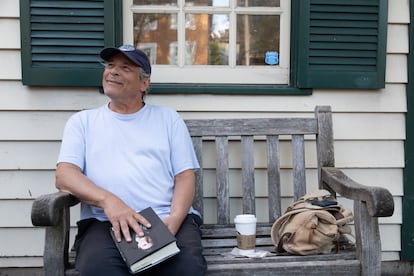
Pennsylvania is, this year, at the heart of the battle for the White House between Vice President Harris and former president Trump. It is the most complex and the most populated of the swing states (which also include North Carolina, Georgia, Michigan, Wisconsin, Arizona and Nevada) that will decide who wins the election. It has 19 electoral votes, making it the biggest prize of the seven swings. Winning it represents an ample chance to emerge victorious on November 5. Losing it blocks many roads to triumph.
“They say that ‘if you win Pennsylvania, you win the whole thing,’” Trump said to his followers at a rally in Wilkes-Barre, an industrial city in the northeastern part of the state, in August. Since 1948, no Democratic candidate has managed to reach the White House without clocking a victory in this state.
Close polls
Polls indicate that the distance between the two candidates is minimal (Harris had a 0.7% lead over her opponent in the FiveThirtyEight poll on September 13), similar to Trump’s lead in 2016, when he defeated Hillary Clinton by 44,200 votes (0.72%) and to when Biden defeated the former president in 2020 by just 82,000 ballots, 1.17% of the total. With numbers like these, every vote counts and every bloc of voters will be key. Convincing one of the scarce undecided votes — 3% of the total, according to a Franklin and Marshall poll from last month — is a step towards that victory lap.
The Democrats and the Republicans have been going all out to win the state. Candidates visit time and time again — it’s no coincidence that the only debate between the two took place in Philadelphia, the state capital. Harris spent four days preparing for it in Pittsburgh, the state’s second-largest town. Last Friday, she returned to hold a rally in Wilkes-Barre. For his part, Trump participated in a meeting with voters in Harrisburg last week. The Republican candidate was shot last July in Pennsylvania’s conservative Butler County.
Democrats have opened 50 campaign offices in the state. Republicans crow that they are arriving in places once considered the territory of their rivals. Both parties have invested more money into television ads that in any state in the country: in August, the Harris campaign spent $56 million; while Trump’s spent $52 million, according to figures from the firm AdImpact. For the fall, they have reserved another $84 and $74 million, respectively.
Aside from being a key state, Pennsylvania is a microcosm of the country, and of this year’s presidential campaign. It’s a region in transition, full of contrasts, where extremely conservative rural roots coexist alongside the progressivism of its big cities, Philadelphia and Pittsburgh. Where the east aligns with the coastal metropolises and the west has more in common with Ohio and the so-called post-industrial and agricultural Rust Belt. Where traditional residents, largely white and older than the country’s average, have seen the Latino population multiple since 2010, especially the Puerto Rican and Dominican population. That community already numbers nearly one million people, and more than 600,000 voters, in a state of 13 million, with the majority of Latinos living in Rust Belt cities like Allentown and Reading.

The state’s economy developed thanks to iron and mining — here, labor unions are still a force to be reckoned with — and Pennsylvania is now trying to reinvent itself in the post-industrial era as a center of logistical, health and technological services, a hub for both fracking and cultural offerings. Lines at food banks in cities like Erie, in the northeast, and fentanyl addicts who live in Philadelphia’s beleaguered Kensington neighborhood make it clear that there is still a long way to go towards this future.
There is one thing that unites all voters: worries about the economy and inflation that has led to soaring prices over the last three years. A total of 82% of voters say this is the issue that most concerns them, according to a study by YouGov.
The manufacturing town of Reading is a small, church-studded version of San Juan, Puerto Rico, where restaurants boast of their lechón asado. In its downtown, nearly all the stores display signs in Spanish. Reggaeton music pumps out of windows. Sarita, who runs a small shop, has placed a table covered with Puerto Rican T-shirts on the street. She waves warmly and smiles as she speaks in Spanish about who she will vote for. “Her, the woman, I don’t know how to pronounce her name. I don’t like the other one.” Her countenance changes when she speaks about her economic situation. She says that she often doesn’t make it to the end of the month, that inflation has eaten up her earnings. “My disability check is no longer enough. Now I have to depend on my daughter to help me every month, but she has her own family and their own needs,” she says, her eyes tearing up.
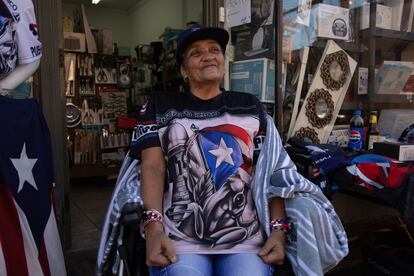
The importance of Pennsylvania has meant that two key aspects of the local economy — that have little resonance outside the state’s borders — have entered into the presidential campaign. One, the nearly $15 billion sale of U.S. Steel to Japanese conglomerate Nippon Steel. Biden and Harris have declared their opposition to leaving the company in foreign hands, in a hat-tip to the unions, but their possible veto of the deal appears to have been delayed, amid warnings from local Democrats that cancelling it would cost jobs. The second issue is fracking, which the vice president now supports after saying in her 2019 presidential campaign that she would ban it.
Other voters mention the defense of individual rights, with special emphasis on abortion, and democracy as being among their top priorities. As well as, immigration. Republicans are calling for a crackdown at the border. “For me, it’s almost the only issue,” says Rebecca Seussman, a Trump supporter based in Newtown. Democrats advocate for immigration reform that combines border security with resolution for cases of individuals already within the United States, and for cooperation towards work on the root causes of displacement. “This is the issue that worries me. I’m going to really study what each candidate is saying and base my vote on that, after seeing which would be best for my community,” says pastor and family therapist Luis Zamot, a resident of outer Philadelphia who is part of the small bloc of undecided voters the campaigns are fighting to win over.
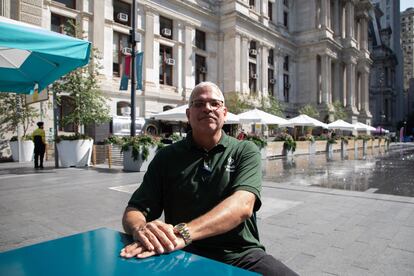
A key Jewish community has also made the war in Gaza one of the campaign’s central issues. In a park on the Allegheny river that crosses the city, educator Heather Mallak, who is married to an Israeli citizen and is a volunteer for the Democrats, says that “the conflict has made many young people, who have no doubt that this is a genocide, think about abstaining. I know a lot of people who lean Democrat who don’t want to vote, but if they don’t vote, that’s basically a ballot for the Republicans. I hope they change their opinion as the campaign goes on, but I also hope and pray that our politicians can put an end to the massive destruction in Gaza and against the Palestinians.”
The two parties have a similar campaign strategy. Mobilize voters in the disctricts where their base is strongest — urban areas, in the case of the Democrats; rural ones, for the Republicans — to win in those regions by large margins. But they will also be on the ground in their rivals’ bastions, to try to snag votes and narrow the lead, hoping for a positive final result. The Democrats see a chance for growth in rural areas that are urbanizing, like Lancaster, in the south; the Republicans, in the Latino community and working-class voters.
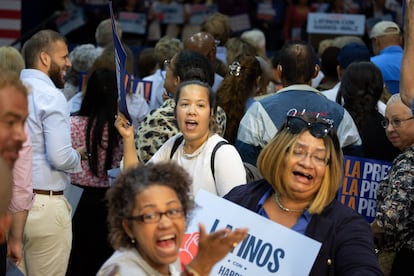
“The vice president understands that to win votes, you have to be everywhere, especially in communities that have been pushed aside and forgotten,” said the state’s governor, Josh Shapiro, in comments he made at the presidential debate last Tuesday in Philadelphia.
In Pittsburgh, Sams Hens-Greco, president of the Democratic committee in Allegheny County — a majority-Harris area — explains: “We are reminding everyone who signed up to vote by mail to do so, sending postcards and text messages. And, of course, we’re going door to door.” This summer’s change at the top of the ticket from Biden to Harris gave the campaign a big boost, he says. “I think we are going to turn out the number [of voters] that we need,” says the Democrat.
Jim Billman, Hens-Greco’s Republican counterpart in Berks County, where Reading is located, was a very busy man last Sunday. The Trump campaign opened an office in the city this summer with the explicit goal of appealing to Latino voters. Traditionally, this bloc has largely supported the Democrats, but Republicans have been gaining ground in recent years; and these voters could be the ones to tip the balance in Pennsylvania to one party or the other. The city was celebrating Puerto Rican Day, an event that filled downtown with Boricua flags, reggaeton and empanada stands. Republicans — just like the Democrats on the other end of the street — set up a booth to register voters. The Republicans’ stand was covered in Spanish language signs, the colors of the U.S. and Puerto Rican flags and was mainly staffed by white, English-speaking volunteers.
“From what they tell me, we’re registering much more voters than the Democrats. We’re going to turn Philadelphia Republican,” says Billman.
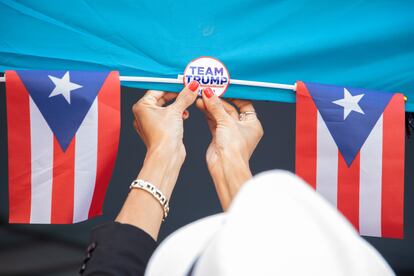
In Allentown, another majority-Latino city just 40 minutes from Reading, the second gentleman, Doug Hoffman, Harris’ husband, led a rally dedicated to the Latino community last week, another sign of the bloc’s relevance leading up to the elections. The mayor of the key town, Matt Tuerk, who is of Cuban descent, recognized that Republicans have made advances in the community, but downplayed their importance.
“Although some people, above all young men, may be attracted to that strongman, dictatorship nonsense, when we talk to the grandmothers, they make sure we remember the dictators of the past and do the right thing” when it comes time to vote, Tuerk explains. The Democratic Party, he notes, has been investing in the Latino vote for years. “It’s not just about speaking their language. It’s about making them feel heard, that they know we understand them,” he says.

In an example of how complicated it can be to reach these marginalized voters, in Reading, some young people from a voter mobilization group approach Salvador, a 24-year-old man who was waiting with his friends for the festival to begin. “I’ve already registered to vote, don’t worry,” he blurts out before they have the chance to say anything. After they leave, he laughs. “Lies. I don’t think I’m going to vote. That guy in the White House seems like just as much a liar to me.”
“Things are very close. There is less than one percent point of difference. We’re coming to the final lap and the last few feet ahead are really complicated,” said Shapiro in Philadelphia.
In Newtown, no one dares to predict a winner. Lane, the former Republican who now votes Democrat, will only comment: “I hope that all the Republican paraphernalia you see in the streets doesn’t translate to the final result.” Redall, the former Democratic voter turned Republican, recognizes that, “everything is so polarized that it’s hard to read the situation.” A few miles away in Philadelphia, Pastor Zamot is still contemplating his vote. “I’ll decide at the last minute,” he says. In all likelihood, so will Philadelphia.
Sign up for our weekly newsletter to get more English-language news coverage from EL PAÍS USA Edition
Tu suscripción se está usando en otro dispositivo
¿Quieres añadir otro usuario a tu suscripción?
Si continúas leyendo en este dispositivo, no se podrá leer en el otro.
FlechaTu suscripción se está usando en otro dispositivo y solo puedes acceder a EL PAÍS desde un dispositivo a la vez.
Si quieres compartir tu cuenta, cambia tu suscripción a la modalidad Premium, así podrás añadir otro usuario. Cada uno accederá con su propia cuenta de email, lo que os permitirá personalizar vuestra experiencia en EL PAÍS.
¿Tienes una suscripción de empresa? Accede aquí para contratar más cuentas.
En el caso de no saber quién está usando tu cuenta, te recomendamos cambiar tu contraseña aquí.
Si decides continuar compartiendo tu cuenta, este mensaje se mostrará en tu dispositivo y en el de la otra persona que está usando tu cuenta de forma indefinida, afectando a tu experiencia de lectura. Puedes consultar aquí los términos y condiciones de la suscripción digital.
More information
Archived In
Últimas noticias
Most viewed
- Sinaloa Cartel war is taking its toll on Los Chapitos
- Oona Chaplin: ‘I told James Cameron that I was living in a treehouse and starting a permaculture project with a friend’
- Reinhard Genzel, Nobel laureate in physics: ‘One-minute videos will never give you the truth’
- Why the price of coffee has skyrocketed: from Brazilian plantations to specialty coffee houses
- Silver prices are going crazy: This is what’s fueling the rally










































